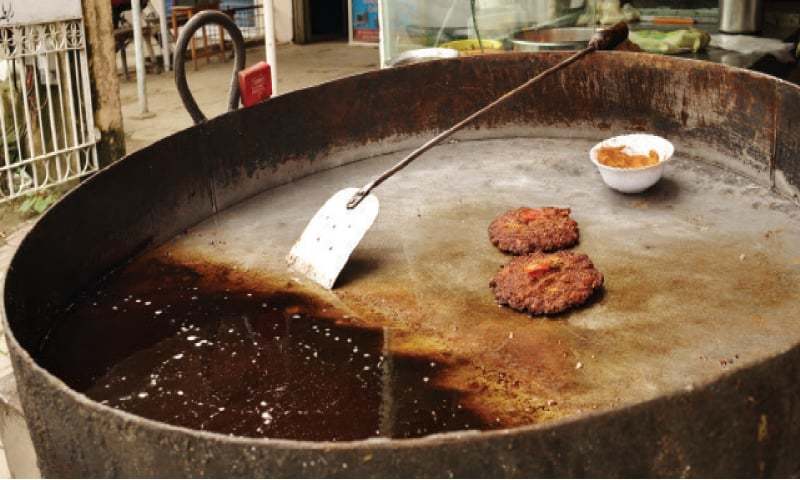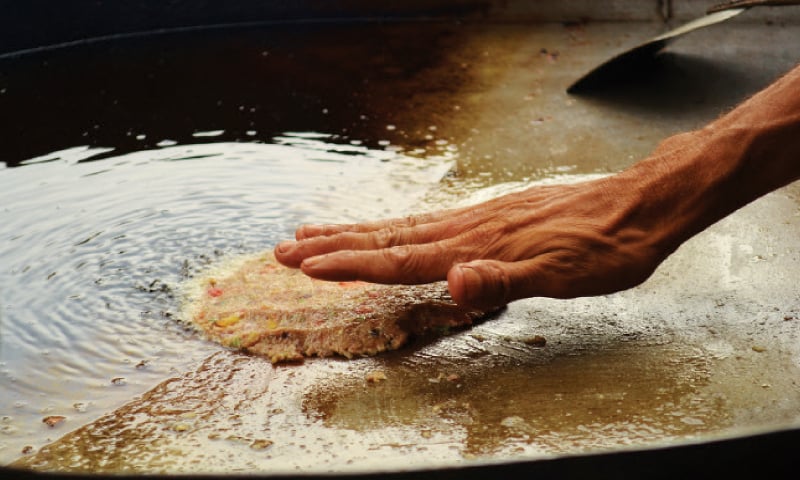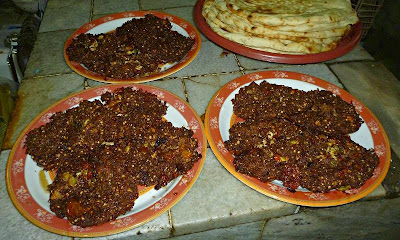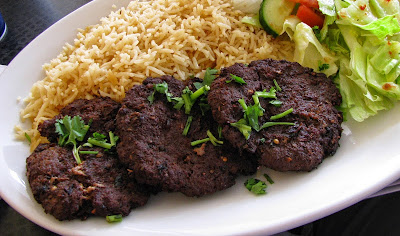ghazi52
PDF THINK TANK: ANALYST

- Joined
- Mar 21, 2007
- Messages
- 101,683
- Reaction score
- 106
- Country
- Location
Khyber’s most delicious export
SHIZA MALIK

Freshly prepared kebabs ready to be savoured.
Chapli Kebab takes its name from the Pashto word Chaprikh, meaning flat. Minced beef or lamb meat is marinated with green chillies, tomatoes, pomegranate seeds, fresh herbs such as coriander and mint and a touch of spice to make this delicious, juicy meat patty.
A succulent Chapli Kebab, scooped up with a hot piece of Kandahri nan and dipped in a yogurt-based chutney, unleashes a bomb of flavour likely to satisfy the most ardent of carnivores.
While Peshawar may be the kebab capital of the world, the Chapli Kebab is thought to have originated in Takhtbhai, Mardan in Khyber Pakhtunkhwa. Today, kebab chefs are divided among two schools - one who associate themselves with Takhtbhai and others who practice the Peshawari method.
In the capital, an obvious place to go looking for this juicy carnivorous treat from the Khyber is the Peshawar Mor. Some of the kebab shops here have been selling Chapli Kebabs for over three decades.
Alam Khan is both the owner and chef at Alam Chapli Kebab and he believes in frying his kebabs in lamb fat rather than vegetable oil. His vat is placed outside the shop on wood-fired stove.
“Being a traditionalist, I believe Chapli Kebab is best cooked in lamb fat and never over a gas stove because the smoke from the wood lends flavour to the kebab,” he says.

Expert hands slide an uncooked Chapli Kebab into oil.
He has been operating his shop in Peshawar Mor for almost 12 years and the art of making kebabs has been in his family for generations.
“My father and grandfather were kebab chefs in Peshawar. Ours is the original Peshawari method,” he said.
According to him, kebab chefs in Peshawar are more likely to use meat from a cow and in Mardan, buffalo meat is more commonly used.

Chef Alam Khan prepares the vat at his shop in Peshawar Mor.
Among the shops in this bazaar, his recipe is the spiciest and retains the salty flavour of melted lamb fat. He also gives a special tomato based chutney with the kebabs, which resembles Mexican salsa and is a perfect accompaniment to the Chapli Kebabs.
But his neighbour Alam Gul at Baba Ji Murgh Pulao insists his recipe uses the most spice.
“I am from Mardan and we are more generous than the Peshawaris, even with our spice,” he quips.
Gul says that he uses vegetable oil to fry the kebabs because in Islamabad people would never prefer to eat something fried in fat.
“Lamb fat is not for novice meat-eaters,” says Gul, as he swiftly flattens a ball of minced meat to make the patty and presses a slice of tomato on top.
The vat for frying the Chapli Kebab is placed at a tilt with deep oil on one side. Expert chefs place the meat patty on the glazed side of the vat and slide the kebab towards the bubbling hot oil. Once ready, the crispy, slightly burnt exterior of the kebab is sprinkled with a bit of spice.
While the competition between the two kebab schools may never be won, Gul’s kebabs are far juicier than his neighbours’. The spice is also fresher with most flavour being lent by green chillies which are used generously.
But no one can talk about Chapli Kebab and not mention the capital’s most famous kebab place, Sufi Resturant. The restaurant which opened in Peshawar Mor some 32 years ago, now also operates from two other branches in Islamabad in Sectors G-6 and F-10.
The founder of the chain Sufi Khan moved here from Nowshera and started from a small kebab place in Peshawar Mor. Sufi Khan’s six sons now jointly run the business.
According to the manager, the Sufi restaurants Chapli Kebabs have retained their position as the best-selling item for all these years.
He refuses to associate Sufi’s kebab recipe with either school and says their recipe is their own unique creation.
“Sufi restaurant uses high quality meat from animals reared at our own farms. We also use quality oil,” he says.
The kebabs themselves although juicy are not very spicy. But the flavour of ginger is very strong and crisp, dark brown exterior combines well with the succulent minced meat interior to make the Capital’s best known Chapli Kebabs.
SHIZA MALIK

Freshly prepared kebabs ready to be savoured.
Chapli Kebab takes its name from the Pashto word Chaprikh, meaning flat. Minced beef or lamb meat is marinated with green chillies, tomatoes, pomegranate seeds, fresh herbs such as coriander and mint and a touch of spice to make this delicious, juicy meat patty.
A succulent Chapli Kebab, scooped up with a hot piece of Kandahri nan and dipped in a yogurt-based chutney, unleashes a bomb of flavour likely to satisfy the most ardent of carnivores.
While Peshawar may be the kebab capital of the world, the Chapli Kebab is thought to have originated in Takhtbhai, Mardan in Khyber Pakhtunkhwa. Today, kebab chefs are divided among two schools - one who associate themselves with Takhtbhai and others who practice the Peshawari method.
In the capital, an obvious place to go looking for this juicy carnivorous treat from the Khyber is the Peshawar Mor. Some of the kebab shops here have been selling Chapli Kebabs for over three decades.
Alam Khan is both the owner and chef at Alam Chapli Kebab and he believes in frying his kebabs in lamb fat rather than vegetable oil. His vat is placed outside the shop on wood-fired stove.
“Being a traditionalist, I believe Chapli Kebab is best cooked in lamb fat and never over a gas stove because the smoke from the wood lends flavour to the kebab,” he says.

Expert hands slide an uncooked Chapli Kebab into oil.
He has been operating his shop in Peshawar Mor for almost 12 years and the art of making kebabs has been in his family for generations.
“My father and grandfather were kebab chefs in Peshawar. Ours is the original Peshawari method,” he said.
According to him, kebab chefs in Peshawar are more likely to use meat from a cow and in Mardan, buffalo meat is more commonly used.

Chef Alam Khan prepares the vat at his shop in Peshawar Mor.
Among the shops in this bazaar, his recipe is the spiciest and retains the salty flavour of melted lamb fat. He also gives a special tomato based chutney with the kebabs, which resembles Mexican salsa and is a perfect accompaniment to the Chapli Kebabs.
But his neighbour Alam Gul at Baba Ji Murgh Pulao insists his recipe uses the most spice.
“I am from Mardan and we are more generous than the Peshawaris, even with our spice,” he quips.
Gul says that he uses vegetable oil to fry the kebabs because in Islamabad people would never prefer to eat something fried in fat.
“Lamb fat is not for novice meat-eaters,” says Gul, as he swiftly flattens a ball of minced meat to make the patty and presses a slice of tomato on top.
The vat for frying the Chapli Kebab is placed at a tilt with deep oil on one side. Expert chefs place the meat patty on the glazed side of the vat and slide the kebab towards the bubbling hot oil. Once ready, the crispy, slightly burnt exterior of the kebab is sprinkled with a bit of spice.
While the competition between the two kebab schools may never be won, Gul’s kebabs are far juicier than his neighbours’. The spice is also fresher with most flavour being lent by green chillies which are used generously.
But no one can talk about Chapli Kebab and not mention the capital’s most famous kebab place, Sufi Resturant. The restaurant which opened in Peshawar Mor some 32 years ago, now also operates from two other branches in Islamabad in Sectors G-6 and F-10.
The founder of the chain Sufi Khan moved here from Nowshera and started from a small kebab place in Peshawar Mor. Sufi Khan’s six sons now jointly run the business.
According to the manager, the Sufi restaurants Chapli Kebabs have retained their position as the best-selling item for all these years.
He refuses to associate Sufi’s kebab recipe with either school and says their recipe is their own unique creation.
“Sufi restaurant uses high quality meat from animals reared at our own farms. We also use quality oil,” he says.
The kebabs themselves although juicy are not very spicy. But the flavour of ginger is very strong and crisp, dark brown exterior combines well with the succulent minced meat interior to make the Capital’s best known Chapli Kebabs.

















